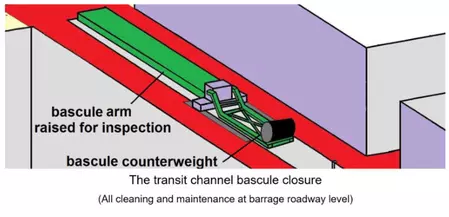Transit Channels
The principal aim is to maintain as near as
practicable the freedom of marine life, both fauna
and flora, to continue to migrate along the Bristol
Channel and the River Severn estuary. The safe
passage of marine life through the barrage has
priority over power generation. Requirements arising
from operational protocols for transit channels must
be met. Only after a design to achieve this has been
established can the barrage electricity generation
capability be established.
The estuary bed varies significantly in depth from
Aberthaw to Minehead. To provide 'unhindered passage'
to all forms of marine life by offering a route
through the water turbines is not a practical
possibility. The location of water turbine intakes at
the level above the estuary bed sufficient to prevent
unacceptable ingress of aggressive sediments and
other flotsam but deep enough to prevent air
entrainment and cavitation problems excludes the
'bottom crawlers and many of the air breathing
residents of the Severn estuary.
Coarse screens can never prevent some creatures
passing through and onto the rotating blades.
Selecting machines that minimise the mortality rate
or the severity of damage to marine life that bypass
such access prevention measures is very welcome but
on its own is not enough. Expecting all marine life
to pass safely through the barrage water turbines is
a non-starter.
Note : Atlantic salmon migrating through the estuary
to river tributaries during September to February are
a special case. Transit for them is made possible.
24/7. On the ebb flow this is achieved by using a
Shipping Channel bascule arm to form a salmon leap.
Their ability to easily leap up weirs of 1.5 metres
in height against the direction of a flow with a
crest of over 10 centimetres has been well
demonstrated.
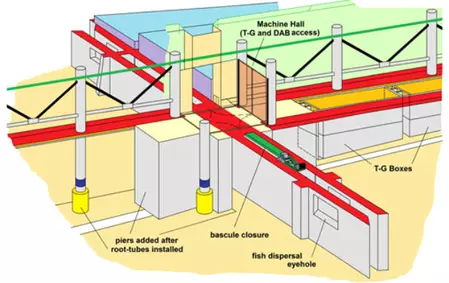
Marine life transit channel layout
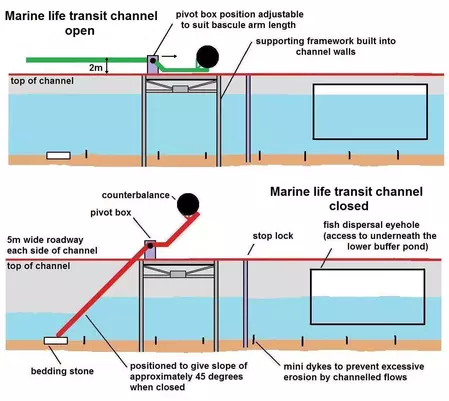
The transit channel bascule closure
This pivot box design is physically adaptable to meet
a changing estuary bed contour. However, a bottom
pivoted bascule design could be substituted if
greater flows became necessary to assist in upstream
level reduction.
Aberthaw-Minehead Tidal Power Station provides
numerous marine life transit channels each with the
bascule closure. The channels are designed to provide
a through route outside the periods of tidal power
generation. Fourteen channels, each of four metre
width, are at locations approximately 850m apart
spread across the barrage. They all extend from the
free estuary surface down to the existing estuary
floor.
The bascule closure has the following important
advantages: -
- All parts are at the surface when the channels
are open giving ready access for maintenance
including the removal of seaweeds, molluscs and
limpet like creatures. This is a simple matter
either by hosepipe or manually.
- On loss of electrical supply to the driving
motors the counterbalance weight chosen ensures
that the bascule arm always falls to the 'closed'
position.
With fourteen marine life transit channels a
malfunction or damage to just one poses no problems
to other aspects of barrage operation. In the event
of a channel not being available for service the
channel must be closed. The four-metre wide channel
is then isolated by 'stop lock' beams until an
opportune time for repair arrives. The marine life
transit channel can be converted into a 'stop-lock'
for this purpose.
The water currents flowing through the transit
channel will erode the estuary bed particularly near
the entrance and exit to each channel. 'Mini dykes'
are provided to prevent excessive erosion but
provision for regular inspection needs to be
made.
Marine life could be exposed to predation when it
emerges from a lengthy relatively narrow channel. The
Aberthaw-Minehead design includes two 'fish dispersal
eyehole' several metres from each channel end. This
allows those able to swim through an eyehole the
possibility of fanning out under the lower buffer
pond and emerging some distance away from the transit
channel.
Four metres is the maximum allowable channel width.
This is determined by the need to avoid a complete
breach of the barrage following a collision by a
large ship that could not be immediately contained
using the measures provided. A ship with a beam
greater than four metres could have considerable
momentum, particularly if travelling under power.
Such a vessel crashing into concrete walls four
metres or less apart would come to a rest before the
end of the 220 metres long transit channel. The
channel could then be isolated using the remaining
'stop lock'. A greater channel width risks craft
reaching and destroying the far stop lock. A
significant breach of the barrage could follow.
Repair of such a breach is very difficult and time
consuming. Power generation may not be possible under
such conditions
The marine life transit channel is crossed by
overhead cranes that run through the Machine Halls.
Infrequently, perhaps once every three months, a
large item such as T-G box may pass through. This
requires the 20 metres high doors to be opened for a
period.
A solid floor covers the transit channel between the
Machine Halls. When Machine Hall doors are open
visual observation from marine life in the transit
channel is prevented. Human activity should be in the
background and pass largely unnoticed.
Migration Aid -
Salmon
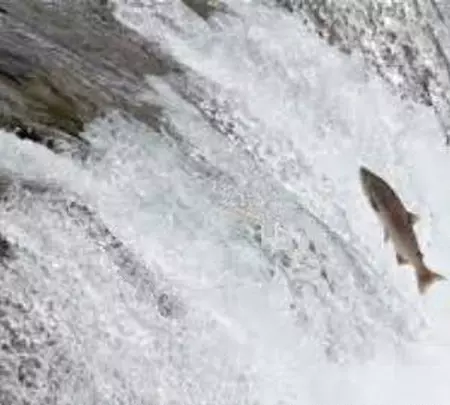
A salmon leaping a Severn weir
A considerable effort has been made in recent years
to encourage the historic migration of salmon through
the Severn estuary and on to the upper reaches of the
various tributary rivers following their journey
across the Atlantic Ocean. Many weirs and other
'obstructions' built across the rivers in the
nineteenth century have now been removed or negated
as an obstacle. The Aberthaw-Minehead barrage design
seeks to support this progress by meeting the special
needs of returning salmon in the September to
February period.
The two-hour opening of the marine life and shipping
transit channels centred on each high-tide and each
low-tide meets the needs of most fish. It does not
impose a restriction on the lives of crabs, lobsters,
eels and the like. Atlantic salmon are the exception.
When making a migratory return to the place of their
birth these salmon are intolerant of delays. The
possibility of salmon finding no way through the
barrage and returning to sea after failing to spawn
must be avoided. However, meeting their special need
is easy. To do this the operating height of the
bascule arms in both shipping channels is positioned
as shown. On a falling tide as each arm is lowered to
form a weir up which the salmon can leap during an
ebb tide. On a rising tide salmon swim in the
direction of the water that is moving upstream
through the transit channel. They pass over the weir
and drop into the upper estuary.
Salmon are naturally gifted and have the ability to
leap 1.5 metre and more with ease against a modest
flow. This is comparable with the level difference at
which Aberthaw-Minehead barrage electrical power can
be generated.
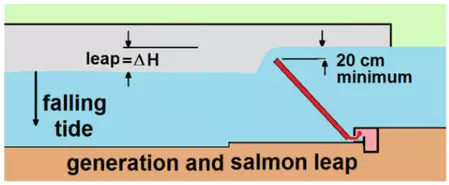
Salmon migration through the shipping & marine life
channels
A minimum height above the weir sills of 20
centimetre is provided at all times to ensure safe
landing. To match the falling tide without
restricting the barrage electrical power generation
capability the weir height is lowered in stepped
increments - one every 60 minutes is suggested.
Water flowing 20-centimetre-deep over a 54 metres
wide rectangular weir does so at a rate of less than
10 cubic metre per second. The velocity is less than
one metre per second. Compared to the normal combined
river flows into the upper estuary of about 250 cubic
metres per second and tidal movements many times
greater still shows 'salmon weirs' to be
insignificant and have no effect on electrical power
generation.

